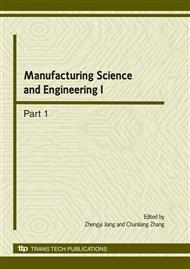[1]
C. Hardin, J. Qu, A. J. Shih: Materials and Manufacturing Processes, Vol. 19(2004), pp.355-359.
Google Scholar
[2]
U.S. Patent Pub. No: US2002/0100469 A1. (2002).
Google Scholar
[3]
H.K. Tonshoff,H. Hillma: Diamond and Related Materials,Vol. 11(2002), pp.742-745.
Google Scholar
[4]
J. Sugawara, H. Hara, A. Mizoguchi: SEI Technical Review, Vol. 58(2004), pp.7-11.
Google Scholar
[5]
Sung Chien-min: United States, 6915796. (2005).
Google Scholar
[6]
Xia ben junzhi: Jewelry Science and Technology, Vol. 16(2004), pp.56-61.
Google Scholar
[7]
K. Furutani, Y. Murase . The 41st CIRP Conference on Manufacturing Systems 2008, Japan.
Google Scholar
[8]
W. Peng, F.Q. Liu: Institution of Engineering and Technology, Vol. 524(2006) pp.2347-2350.
Google Scholar
[9]
W. Peng, T. Gao, C. Y. Yao: Key Engineering Materials, Vol. 304-305(2006), pp.71-75.
Google Scholar
[10]
F.Q. Liu, C.Y. Yao, W. Peng: Advanced Materials Research, V0l. 24-25(2007), pp.289-294.
Google Scholar
[11]
W.I. Clark, A.J. Shih, C.W. Hardin, R.L. Lemaster, S.B. McSpadden: International Journal of Machine Tools and Manufacture, Vol. 43(2003), pp.523-532.
DOI: 10.1016/s0890-6955(02)00215-8
Google Scholar
[12]
W.I. Clark, A.J. Shih, R.L. Lemaster, S.B. McSpadden: International Journal of Machine Tools and Manufacture, Vol. 43(2003), pp.533-542.
DOI: 10.1016/s0890-6955(02)00216-x
Google Scholar
[13]
P Q Ge, L Zhang, W Gao, Z C Liu. Journal: Materials Science Forum, Vols. 471-472(2004), pp.481-484.
Google Scholar
[14]
K. Furutani, M. Kanai, Y. Mieda, M. Suzuki: Proceedings of AMPT (2006), Las Vegas, USA.
Google Scholar
[15]
K. Furutani, H. Sunada: International Journal of Electronic and Machine, Vol. 9(2004), pp.15-20.
Google Scholar
[16]
Y. Chiba, Y. Tani, H. Sato: CIRP Annals Manufacturing Technology, Vol. 52(2003), pp.281-284.
Google Scholar
[17]
E. C. Leea,J. W. Choi: Surface Coat Technology,V0l. 148(2001),pp.234-237.
Google Scholar
[18]
John B. Hodsden, Jeffrey B. Hodsden: US Patent Number 6065462. (2000).
Google Scholar
[19]
J. B. Hodsden: US Patent Number 6, 279, 564. (2001).
Google Scholar
[20]
T. Enomoto, Y. Shimazaki, Y. Tani, Y. Kanda: Annls of the CIRP, Vol. 48 (1999) , pp.273-276.
Google Scholar
[21]
T. Enomoto, Y. Tani, T. Tetsuhiro: Journal of the Japan Society for Precision Engineering Vol. 68(2002), pp.1481-1485.
Google Scholar
[22]
C.Y. Yao, W. Peng, M. H Wang: Advannced Material Research, 2009. 5 Vols. 69-70, pp.328-332.
Google Scholar
[23]
F. Liu, W. Peng, C.Y. Yao: International Journal of Computer Applications in Technology, Vol. 29(2007), pp.155-158.
Google Scholar


